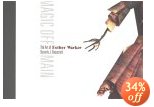Magic Off Main: The Art of Esther Warkov

by Beverly J. Rasporich, Esther Warkov
ISBN: 1552380998
Post Your Opinion | | A Review of: Magic Off Main: The Art of Esther Warkov
by Olga SteinMagic off Main arrived in my office late in December 03, too late
to be included in last year's gift books column. This was unfortunate
because the small book, with its tasteful but unassuming cover,
immediately revealed itself as a treasure. Esther Warkov's work is
completely unconventional, brilliant, disturbing, confounding, and
at all times fascinating. So striking is Warkov's art, I wondered
why I had never heard of her before. Fortunately, Magic Off Main
does not merely reproduce Warkov's paintings and three-dimensional
art, the book is an expertly written study of the artist's oeuvre,
her personal history and the historical and geographical context
which helped shape her artistic imagination and motivations.
Born on October 12, 1941, to Morris Warkov, a Jewish immigrant,
and Sarah Schulman, a first-generation Jewish Canadian, Esther was
raised in the ethnically mixed, polyglot North End of Winnipeg. As
a child, at the Warkov's store on Selkirk street, she would see and
handle the myriad small objects for sale to farmers and other working
men. Her art, always a collage, mixes disparate organic and inorganic
elements. Warkov's use of objects bespeaks the fascination she has
retained since childhood for things that are visually interesting
in themselves but represent in addition Winnipeg's larger,
industry-related, social-economic realities. The figures and organic
components of her art are inspired by the ethnically varied denizens
of her Winnipeg milieu, Jews and Christians, as well as persons
from history and popular culture, and by the flowers and fields
which are so much part of Manitoba's prairie landscapes.
Warkov's work is decidedly post-modern in its reliance on
miscellany-innumerable unrelated items brought together in outlandish
synthesis, which Beverly Rasporich repeatedly emphasizes, has
personal' meaning for Warkov. The historical or present-day
significance of these assemblages is hard to decipher for this very
reason, though certain themes clearly engage Warkov and we see these
treated time and again-in particular, the problem of retelling the
past. The retelling suffers from snapshots, the lie of a frozen
moment, the inadequacy of a part in representing the whole, and,
as Warkov's reflexive irony reminds us, the artist's own collusion
in bringing about that illusory or unfaithful reconstruction.
Rasporich writes:
"In Warkov's camera series, the works present highly stylized
realist images in magical spatial contexts. In Ice, Cat, Shutter
Street Rabbi, Dreamscape, Captured, The House of Cranach, Mourning
Miranda, Snap, and Memory through a Telescope, old-fashioned camera
boxes, a television set, a modern camera, and a telescope are
technologies that are undermined through the painting of their
surfaces, or the background, with images of nature: landscapes,
skyscapes, flowers, and birds."
Esther Warkov was influenced by Surrealists such as Max Ernst and
Ren Magritte, but the images she gathers and juxtaposes aren't
intended to evoke the unconscious, its subterranean associations
and fears. Instead, in postmodern tradition, her brand of magic and
realism consciously subverts, satirizes and exposes the false and
distorted images-of women, ethnic and racial groups, and of past
events-created and safeguarded by mass culture. Always present in
Warkov's art is social commentary within a narrative arrayed as a
fabulist's tableau.
|